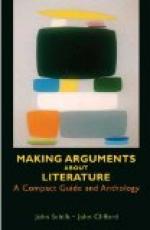In a college or school argument you will usually follow it rather closely; and you do well to do so, for you will thus fix in your mind a useful model. But when you get out into the world, you will have to consider in each case the needs and prepossessions of the particular audience. Here as everywhere in the argument you must exercise judgment; there is no formula which will fit all cases. The scheme of analysis of the case which has been expounded in Chapter II has stood the test as the best means yet found of exploring a subject and insuring clarity of thought and certainty of attack;[57] but I know of no single fixed scheme for the argument itself which will not be racked apart by the first half dozen practical arguments you apply it to.
51. The Body of the Argument. In the main body of the argument the difference from the brief will be largely a matter of expansion: the brief indicates the evidence, the argument states it at length. Here again you cut your argument to fit your audience and the space at your command. In an argument in the editorial of a newspaper, which is rarely longer than a long college theme, there is little space for the statement of evidence. In Webster’s argument in the White Murder Case, which has some thirteen thousand words and which must have taken two hours or more to deliver, the facts are studied in minute detail. Most people are surprised to see the way in which a full statement of evidence eats up space; if the facts are at all complicated, they must be analyzed and expounded one by one and their bearing on the case laid out in full. This necessity of using space in order to make facts clear is the reason why it is so hard to find adequate and convincing arguments which will print in less than fifteen or twenty pages. The trouble with a swift and compact argument like that of Macaulay’s on the authorship of the Junius Letters (see p. 155) is that unless you have gone into the question for yourself, you do not know whether to accept the stated facts or not. If you do accept them, the conclusion is inevitable; but if you happen to know that scholars have long held the decision doubtful, you want to know more about the facts in detail before surrendering to Macaulay’s conclusion. For an average reader to-day, who knows little of the facts, this argument would have to be greatly expanded.
In this expansion comes the chance for all the skill in exposition that you can muster, and for that subtle appeal to your readers’ feelings which lies in vividness and precision of phrasing, considerations with which I will deal separately further on. Questions of proportion of space we may consider here.
The only rule that can be laid down for the distribution of your space is to use your sagacity, and all your knowledge of your subject and of your audience. In a written argument you have the advantage that you can let your pen run on your first draft, and then go back and weigh the comparative force of the different parts of the argument, and cut out and cut down until your best points for the purpose have the most space. In a debate the same end is gained by rehearsals of the main speeches; in the rebuttal, which is best when it is spontaneous, you have to trust to the judgment gained by practice.




